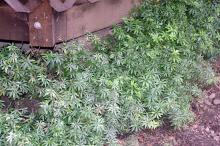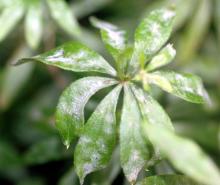Cause Likely the fungus Neoerysiphe galii since a dense mycelial mat is formed, but 3 different species of Golovinomyces also occur worldwide. Golovinomyces cichoracearum, has been reported for the PNW. These fungi are favored by conditions that produce high humidity but dry leaves. They are highly specialized pathogens that form close associations with hosts. Conditions that favor the host also favor the pathogen. Much of the fungus remains outside infected plant parts where it grows on the surface but sinks root-like structures called haustoria into plant cells to obtain nutrients. The white growth seen is composed of both mycelium and fungal spores.
Symptoms Plants develop scattered white, chalky spots in late spring near the end of flowering. White patches on leaves continue to develop until much of the leaves are covered with a dull white coating and become chlorotic. Plants may decline rapidly and prematurely in the summer due to these infections.
Cultural control
- Grow in partial shade rather than full shade.
- Space plants for good air circulation.
Chemical control There are no fungicides specially labeled for this plant. (See Greenhouse Plants, Ornamental-Powdery Mildew for a list of possible fungicides.) Many of these can be legally used. Test first on a small section before applying on the whole plant to evaluate possible phytotoxicity.
Reference Takamatsu, S., Heluta, V., Havrylenko, M., and Divarangkoon, R. 2009. Four powdery mildew species with catenate conidia infect Galium: molecular and morphological evidence. Mycological Research 113:117-129.



